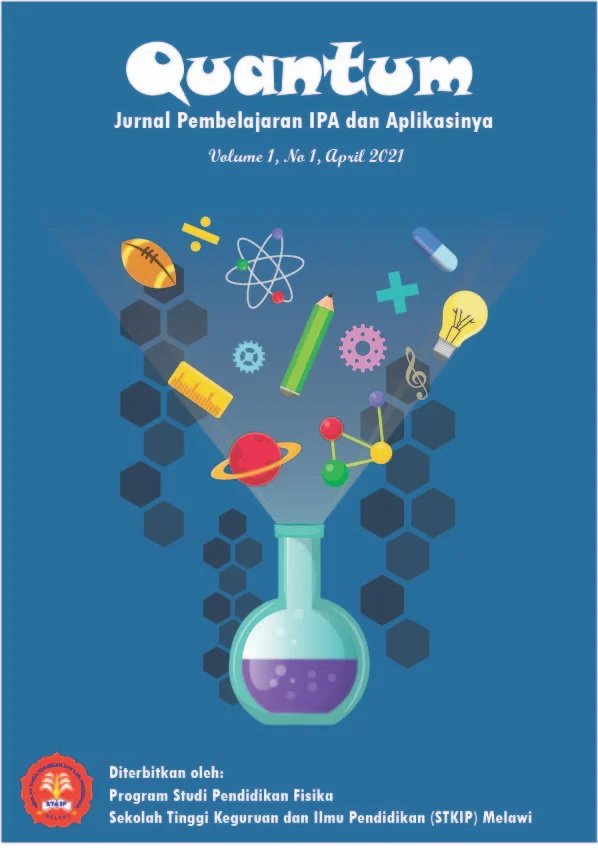Pemahaman Mahasiswa tentang Konsep Fisika dalam Al-Qur'an: Analisis Fenomena Alam pada Ayat-Ayat Kauniyah
DOI:
https://doi.org/10.46368/qjpia.v5i1.3620Abstract
Science and religion are often regarded as distinct domains, yet they can complement each other in understanding the universe. This study aims to describe students understanding of physical science concepts in the kauniyah verses of the Qur'an. A descriptive method with a qualitative approach was used. A total of ten physics education students were selected as participants using a purposive sampling technique. Data were collected through semi-structured interviews and analyzed thematically. The findings reveal that most students could relate kauniyah verses to physical concepts such as Earth's rotation, time relativity, tectonic plates movement, and light. However, variations in understanding were found, with some students emphasizing religious aspects without deep scientific reasoning. These results highlight the importance of integrating science and Islamic values in learning to strengthen students conceptual understanding.
Keywords: kauniyah verses, physical phenomena, Islam-science integration
References
Al-Battani. (2005). Astronomi Islam dan Hukum Gerak Benda. Penerbit Ilmu Islam.
Bogdan, R., & Biklen, S. K. (2007). Qualitative Research for Education: An Introduction to Theory and Methods. Pearson.
Creswell, J. W., & Creswell, J. D. (2018). Research Design: Qualitative, Quantitative, and Mixed Methods Approaches (5th ed.). Thousand Oaks, CA: SAGE Publications.
Hidayat, A., Nurdin, E., & Fauzi, R. (2018). Hubungan antara Konsep Fisika dan Al-Qur'an: Analisis Pemahaman Siswa yang Berlatar Belakang Pondok Pesantren. Proceeding Seminar Nasional Pascasarjana UNNES, 646-564. Jurnal Integrasi Sains dan Islam: https://journal.unida.gontor.ac.id/index.php/JSI.
Karim, M. (2017). Korelasi Hasil Belajar Fisika Dasar dan Tafsir Terhadap Kemampuan Integrasi bagi Mahasiswa. Phenomenon: Jurnal Pendidikan MIPA, 7(1), 90-101. https://journal.walisongo.ac.id/index.php/Phenomenon/article/view/90.
Kementerian Riset, Teknologi, dan Pendidikan Tinggi. (2017). Rencana Induk Riset Nasional 2017-2045.
Kenedi, K. A., Ramadhani, D., Sukirno, Fransyaigu, R., Asnawi, & Mulyahati, B. (2020). Mathematical connection ability of elementary school students during the Covid-19 pandemic. In Proceedings of the 2nd International Conference on Science, Technology, and Modern Society (ICSTMS 2020). https://doi.org/10.2991/assehr.k.210909.060
Merriam, S. B. (2009). Qualitative Research: A Guide to Design and Implementation. Jossey-Bass.
Miles, M. B., & Huberman, A. M. (1994). Qualitative Data Analysis: An Expanded Sourcebook. SAGE Publications.
Misbah, M. (2017). Integrasi sains dan agama dalam pembelajaran fisika: Upaya membangun spiritualitas dan saintifik siswa. Jurnal Tadris Fisika Indonesia (JTFI), 5(1), 1–6. https://doi.org/10.29303/jtfi.v5i1.250
Mualimin, & Subali, B. (2018). The integration of Al-Qur’an and Hadith studies on biology learning at Islamic senior high schools in Magelang, Indonesia. Journal of Physics: Conference Series, 1097(1), 012045. https://doi.org/10.1088/1742-6596/1097/1/012045
Mustofa, I. (2020). Integrasi Nilai-Nilai Ketauhidan pada Pengajaran Fisika. Jurnal Kalam: Kajian Islam dan Pendidikan, 14(2), 13-25. https://journal.lsamaaceh.com/index.php/kalam/article/download/14/13.
Nasir, M. (2019). Integrasi Sains dan Islam: Kajian Ayat-Ayat Kauniyah dalam Al-Qur'an. Jakarta: Pustaka Ilmu.
Nasr, S. H. (1996). Science & Civilization in Islam. Harvard University Press.
Nassaji, H. (2015). Qualitative and descriptive research: Data type versus data analysis. Language Teaching Research, 19(2), 129–132. https://doi.org/10.1177/1362168815572747
Patton, M. Q. (2015). Qualitative Research & Evaluation Methods: Integrating Theory and Practice. SAGE Publications.
Rahman, A. (2021). Pemahaman Mahasiswa tentang Ilmu Sains dalam Perspektif Islam. Bandung: Al-Kautsar Press.
Rusydi, A. (2016). Tafsir Ayat Kauniyah. Al Qalam: Jurnal Ilmiah Keagamaan dan Kemasyarakatan, 9(17), 122-125. https://jurnal.stiq-amuntai.ac.id/index.php/al-qalam/article/download/56/42.
Saregar, S. (2016). Analisis Pemahaman Konsep dan Sikap Siswa Terhadap Belajar Fisika. Jurnal Ilmiah Pendidikan Fisika Al-Biruni, 5(1), 1-10. https://jep.ppj.unp.ac.id/index.php/jep/article/download/599/213.
Sugiyono. (2017). Metode Penelitian Kualitatif, Kuantitatif, dan R&D. Bandung: Alfabeta.
Yusuf, M. Q., & Asyari, A. (2020). Integrasi sains dan Islam dalam ayat-ayat kauniyah: Telaah tafsir tematik. Jurnal Ilmu Al-Qur’an dan Tafsir, 11(1), 55–70. https://doi.org/10.21043/jiqt.v11i1.7061
Yusuf, R., & Hakim, T. (2020). Relativitas dalam Al-Qur’an dan Implikasinya terhadap Ilmu Fisika Modern. Yogyakarta: Cahaya Ilmu.
Downloads
Published
How to Cite
Issue
Section
Citation Check
License
Copyright (c) 2025 QUANTUM: Jurnal Pembelajaran IPA dan Aplikasinya

This work is licensed under a Creative Commons Attribution-NonCommercial-ShareAlike 4.0 International License.
Penulis yang menerbitkan jurnal ini menyetujui persyaratan berikut:
Penulis memiliki hak cipta dan memberikan hak jurnal untuk publikasi pertama dengan karya yang secara simultan dilisensikan di bawah Lisensi Atribusi Creative Commons yang memungkinkan orang lain untuk berbagi karya dengan pengakuan kepengarangan karya dan publikasi awal dalam jurnal ini.
Penulis dapat membuat perjanjian kontrak tambahan yang terpisah untuk distribusi non-eksklusif versi jurnal yang diterbitkan dari karya tersebut (misalnya, mempostingnya ke repositori institusional atau menerbitkannya dalam sebuah buku), dengan pengakuan atas publikasi awalnya di jurnal ini.
Penulis diizinkan dan didorong untuk memposting pekerjaan mereka secara online (mis., Dalam repositori institusional atau di situs web mereka) sebelum dan selama proses pengiriman, karena dapat menyebabkan pertukaran yang produktif, serta kutipan yang lebih awal dan lebih besar dari karya yang diterbitkan.





